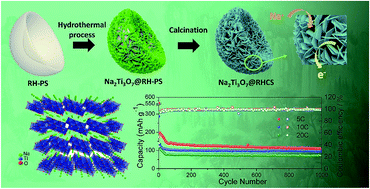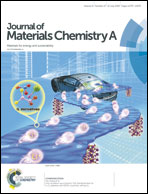Red blood cell-like hollow carbon sphere anchored ultrathin Na2Ti3O7 nanosheets as long cycling and high rate-performance anodes for sodium-ion batteries†
Abstract
Sodium titanate (Na2Ti3O7) has been proved to be a potential anode material for sodium-ion batteries. However, its poor rate capability and low electrical conductivity has seriously hindered its application. Therefore, a unique red blood cell-like hollow carbon sphere supported Na2Ti3O7 sodium titanate nanosheet structure (Na2Ti3O7@RHCS) was designed here, which can both improve the electrical conductivity and preserve the structural stability, thus obtaining high rate performance. In addition, the red blood cell-like spherical structure can greatly increase the compacted density via a dense packing mode just like red blood cells stacked together one by one. Meanwhile, the ultrathin nanosheet-like morphology of Na2Ti3O7 could further increase the number of active reaction sites and reduce the diffusion path of sodium ions during the charge–discharge process. This well-designed material exhibits a good cycling performance: a reversible capacity of 110.46 mA h g−1 at 5C and 45.71 mA h g−1 at 50C.



 Please wait while we load your content...
Please wait while we load your content...